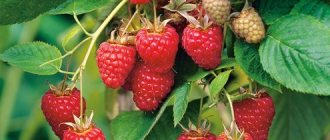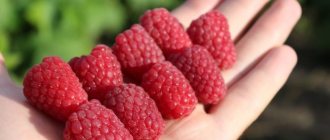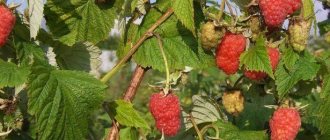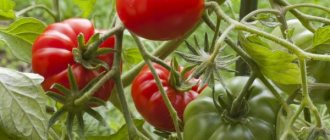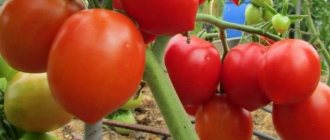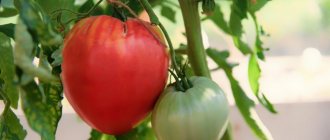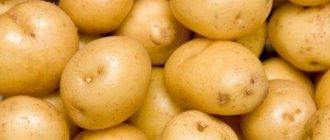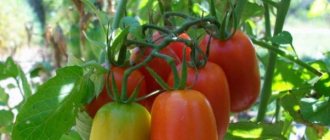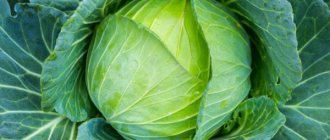Raspberry Krepysh is a standard variety of domestic selection, the distinctive feature of which is the thickness and strength of the stem, which allows you to grow the crop without tying or supports.
Raspberry variety “Strong”
large, beautiful raspberries “Krepysh” juicy and sweet
The highlight of the “Krepysh” variety is that its bushes do not need a garter and there are absolutely no thorns on them
Description of Strongman
Standard raspberries are popularly called raspberry trees. Indeed, a developed adult plant vaguely resembles a small tree, but it is the same bush as all other types of raspberries.
Bushes
The variety lives up to its name - the plant is strong and stocky. Not only the main trunk, but also the remaining shoots are thick and hard. A standard-type bush, 1.8 m high, can reach 2 m. Powerful thornless shoots (up to 2 cm thick) have short internodes and multiple lateral branches.
In the first year after planting, the color of the stems is green; in the second year, their color becomes yellow-brown. The leaves are strongly corrugated, dark green. Fruiting branches are formed only in the upper part of the plant. There are quite a lot of them, they are short and compact.
Berries
The fruits are a rich red-raspberry color, without shine, a beautiful blunt-conical shape, large, weighing up to 10 g. A big plus is the dense pulp of the berries, thanks to which they have a dry surface, while remaining juicy inside.
The fruits of the Krepysh raspberry are endowed with an interesting feature: immediately before ripening, literally 1-2 days, there is a rapid increase in the size and weight of the berries.
Ripe berries are easily separated from the stalks and are not deformed during collection and transportation. Overripe fruits do not fall off, but gradually dry out, remaining on the branches.
Description of the variety
Raspberry is a standard plant. This means that for normal growth and development it needs support. The variety was bred by Russian breeder V. Kichina in the Kokinsky stronghold. A distinctive feature of standard plants is that they securely hold the berries and the branches often bend under the weight of the harvest. A garter to the support prevents them from breaking off and helps shape the crown.
But the “strong man” is called that because this precaution is not obligatory for him. The shrub has powerful and large stem branches with short internodes and an abundance of lateral shoots. The fruits ripen in the upper part of the bush, which makes it possible to compare the robust plant with a small tree.
The peculiarity of the variety is that it bears fruit throughout the summer and the first half of autumn, until the first frost. This is its advantage and disadvantage. The “plus” is that the gardener always has a harvest of fresh berries. The “minus” is their unfriendly, uneven ripening, which requires constant attention and regular picking of berries.
This can become a serious problem when growing the variety on an industrial scale or at the level of a large farm. But for a small summer cottage, there are more positive aspects to growing strong raspberries than negative ones.
Variety characteristics:
- high growth rate;
- at
Fertility with proper care - up to 4 kg per bush;
- reaches a height of 180-200 cm;
- the tops of the shoots are strong and do not bend under the pressure of the wind and the weight of the fruit;
- resilient, able to tolerate frosts down to -30°C;
- a bush without thorns, which makes it easier to care for and harvest;
- flowering period – June-July;
- the fruits ripen on last year's shoots.
The berries are distinguished by high taste, sweet, with a pronounced aroma. The color is bright red. The size is large, the average weight is 6-8 g. One of the advantages of the variety is that the berries adhere well to the stalks and do not fall off even when fully ripe. They are distinguished by high shelf life and, in comparison with most other varieties, retain their presentation for a long time. This is important when growing raspberries for sale.
See also the article about a similar type of raspberry: Tibetan raspberry (rose-leaved)
Advantages and disadvantages of the variety
The advantages of the Krepysh variety include:
- stable generous harvests with proper agricultural technology;
- large beautiful berries;
- the absence of thorns on the stems, which makes picking berries more convenient;
- high frost resistance;
- stem strength;
- increased resistance to diseases and pests;
- there is no need for supports;
- long fruiting;
- the bush has slightly thickened shoots and does not grow;
- The dense structure of the fruit allows you to maintain high commercial quality during transportation and storage.
Weaknesses of the variety:
- long wait for the first berries and full fruiting;
- uneven ripening (for commercial cultivation);
- the bush does not tolerate mechanical damage;
- sensitive to transplantation, long period of survival in a new place.
Watch a review of the “Krepysh” raspberry variety in the video below:
Raspberry variety Krepysh: description, photos, reviews, secrets of planting and care
03.02.2018
The beautiful, tasty nickname “raspberry tree” is ideal for the standard raspberry variety Krepysh. A substantial plant with a powerful two-meter trunk and many “branches” strewn with large fruits looks very attractive and deservedly wins its place in gardens and vegetable gardens from ordinary garden raspberries.
Description of the variety
The raspberry variety Krepysh was obtained at the end of the 20th century by Russian breeders VSTISP and lives up to its name very well.
- the shoots are powerful, up to 2 m high, withstand strong winds and the weight of a bountiful harvest, do not require support or garter, have short internodes and numerous lateral branches;
- the stems of the first year are green, in the second year they become brownish-yellow;
You might be interested! Description of the second most popular variety of raspberry trees - standard raspberry Skazka.
- leaves are dark green, highly corrugated;
- Krepysh raspberries practically do not form thorns;
- The berries are set on the shoots of the second year of life; when ripe, they are easily separated from the stalks, but do not fall off from their own weight. Ripe fruits are large, sweet and sour in taste, suitable for both fresh consumption and canning. The color of the berries is bright red. The berries are dense, have good transportability and are perfectly stored;
- The variety is considered mid-early; berries are collected from June to early August.
- If you follow the rules of care, the yield of the Krepysh variety reaches 4 kg. from one bush.
- The robust variety is resistant to low temperatures and tolerates cold snaps down to -30 degrees; the variety is highly resistant to pests and diseases, especially fungal infections.
- The peculiarities of the variety include poor tolerance to damage. If a large branch is accidentally broken, this can negatively affect the entire plant until it dies. Replanting is also stressful for the plant; after digging up and changing the location, the variety may take up to 2 years to restore fruiting;
- Another feature of Krepysh can be considered the long period of formation of a full-fledged tree. The seedlings will begin to bear fruit only 2-3 years after planting, and the maximum yield will be by the 5th year of the bush’s life, but this is more than compensated by the abundance of the harvest and the duration of ripening of the berries.
Standard varieties of raspberries require increased attention to pruning; it is necessary to form a raspberry tree from the shoot by pinching the tops and actively forming side shoots.
Advantages of the variety
- resistance to pests and diseases;
- immunity to fungal infections;
- frost resistance;
- no need for supports;
- strength of stems and trunk;
- fruit strength and suitability for long-term transportation;
- high productivity;
- ease of care and feeding;
- absence of thorns on the stems;
- long-term fruiting.
Disadvantages of the variety
- a long period until the first fruits and full fruiting;
- uneven ripening (for cultivation on an industrial scale);
- sensitivity to transplantation and a long period of survival in a new place;
- poor tolerance to mechanical damage.
The list of advantages of this variety clearly exceeds the negative points, and many of them are very conditional.
Landing
Planting a new raspberry variety in the garden always begins with selecting seedlings. In planting material of the Krepysh variety, you need to pay attention to:
- stem diameter (from 1 cm);
- tree-like strong stem;
- the presence of at least three buds at the base.
A seedling that meets all of the above requirements is considered ideal due to its optimal age and rooting period. Cuttings with fewer than three buds can also take root, but will take much longer to develop before fruiting. Thin stems (less than 1 cm) may take root poorly, but a woody stem will ensure rapid rooting and adaptation to a new location.
You might be interested! Description of the thornless pride of Russian breeders - the raspberry variety Ispolin.
It is recommended to prepare the land for planting Krepysha a month in advance. A flat, sunny area, protected from the wind, is carefully dug up to a depth of at least 20 cm, all weeds are removed and the ground is covered with sand at the rate of a bucket per 1 m2. Best time for planting: March-April and September-October.
Krepysh is a standard raspberry variety, so when planting it is necessary to immediately maintain sufficient distances between neighboring plants. Seedlings are planted in holes measuring 30*60 cm in a checkerboard pattern with an interval of at least 0.5 m between bushes. Fertilizer (100 grams) is first applied to each hole.
nitroammofoski, a bucket of peat and 200 gr. ash), then the seedling is carefully placed in the hole without allowing the root collar to submerge, it should be located flush with the ground, and covered with earth. After planting, raspberry branches are cut to 30 cm, watered abundantly and mulched with humus, straw or peat.
An important point: the greater the distance between the bushes, the richer the harvest awaits us in the future.
Growing and care
Growing the Krepysh variety is quite standard, except that this raspberry does not require support or garter. The basis of care should be weeding, loosening the soil, fertilizing and watering.
Watering
During the fruiting period, you should pay special attention to watering. Raspberries need to be watered every 5 days (5 liters per bush). Everything is simple here - the hotter and drier the summer, the more often the raspberries are watered.
But you should not allow excess moisture, as the roots may rot and the plant will die. Also, high temperatures and high humidity can provoke the appearance of aphids or caterpillars in the raspberry field.
The bush is responsive to loosening, but this procedure must be carried out carefully, to a depth of no more than 5 cm, so as not to damage the root system of the bush.
Trimming
Pruning of raspberries is carried out in the spring, with the onset of warm weather - the stems of the second year are cut 10-15 cm from the top to stimulate the appearance of new dense side shoots, as well as all dry and damaged branches. During autumn pruning, all fruit-bearing branches are removed, leaving 4-6 new shoots. Root shoots are completely removed during the summer season.
Top dressing
Applying fertilizers during planting allows you to forget about fertilizing for 3-4 years, but in the future it is the fertilizing that affects the size of the harvest and the size of the fruit. Raspberry Krepysh is responsive to the addition of chicken manure and urea with ash. After applying fertilizers, the soil is well loosened, watered and mulched. The variety prefers liquid organic fertilizers.
For example, mullein with water 1:10, bird droppings 1:20 (about 4 liters of solution per 1 m2). The first feeding is carried out in late May - early June. At the end of the fruiting season, fertilizing with phosphorus and potassium is carried out.
This stimulates the development of the root system and strengthens the stems. In the fall, you cannot use nitrogen fertilizers, they stimulate growth, and instead of preparing for winter, raspberries will begin to grow leaves.
Reproduction
In the first year, young raspberry bushes only form roots, in the second year a few young shoots appear, in the third year the number of “babies” seriously increases and you will have to start fighting the “raspberry invasion” of the garden. To independently propagate the variety, it is enough to leave a few young plants, and after the stem has become woody, in the second year of life, dig it up and plant it in a new bed.
Reviews
Growing Krepysh raspberries is a pleasure. The main thing is to water well from May to August, regularly weed, observe pest prevention and loosen the soil.
There will be no problems with insects if you treat Krepysh raspberries with Bordeaux mixture in early spring. If it doesn’t work, then for the raspberry beetle - Karbofos, Fufanon, for the gall midge - cut off and burn the diseased shoots. Infusion of wormwood, tobacco, walnut - spray in the evening.”
Strong is my favorite variety. Unpretentious and productive. The berries do not fall off or become mush during transportation.
Standard raspberries in general, and the Krepysh variety in particular, require attention, time and care, but also reward in full. The opportunity to collect ripe, juicy fruits from tall, thornless bushes that do not wrinkle during transportation, and even throughout almost the entire summer, is a very tempting pleasure and worth the effort.
Raspberry variety Krepysh: description, photos, reviews, secrets of planting and care Link to main publication
Source: https://egemalina.ru/sorta/krepysh
Ripening time and yield
Krepysh raspberries are cultivated in the Central and Central Black Earth regions, Kuban and central Russia.
This is a mid-early variety. The ripening time for Krepysh is June-August. Ripening dates may shift slightly in one direction or another depending on weather conditions. In the sun, berries ripen more actively than during prolonged rains.
The harvest ripens on last year's shoots, and unevenly. This has its pros and cons. The plus is that you can enjoy fresh berries for a long time, but the minus rather concerns commercial gardening. Such uneven ripening is a serious obstacle to harvesting and marketing.
In one bunch of 6-9 berries, only one can be ripe; the rest will take 1-2 weeks to ripen.
The productivity of Krepysh raspberries is high. With the right agricultural technology, you can remove up to 4 kg of berries from a bush.
Boarding time
The optimal planting periods are spring and autumn. Each gardener chooses the most convenient option for him, depending on the situation and circumstances.
Pros and cons of spring and autumn planting
| Boarding time | pros | Minuses |
| Spring |
|
|
| Autumn |
|
|
When do you prefer to plant raspberries?
SpringAutumn
Experienced gardeners recommend starting to plant seedlings in mid-October.
Selection of seedlings
You need to approach the purchase of seedlings responsibly; good harvests can only be expected from high-quality planting material:
- For a seedling, a branched root system with an abundance of small roots is important;
- the stem diameter of a young standard seedling is at least 1 cm;
- stem woody, strong;
- absence of swellings on the stem.
The presence of a woody stem and a developed root system will allow the plant to more easily adapt to a new location. The length of the stem does not matter; it is still shortened when planting; its diameter is important. Seedlings with thin stems have poor survival rate.
The stem of a plant purchased from a nursery usually already has buds removed from the roots to a certain height. This will be the raspberry trunk. The seedling is already initially prepared for proper development and formation. Higher up the stem there should be buds, from which fruiting shoots will then grow.
In the air, especially in the sun, raspberry roots dry out quickly, so the root system of the purchased seedling is wrapped in a wet cloth and placed in a plastic bag.
Choosing a landing site
For planting standard raspberries, choose a sunny area with a flat surface and protected from northern winds. The place under the raspberry tree should not be flooded by rain and melt water. The plant does not tolerate excess moisture.
For good fruiting, Krepysh needs soil that is slightly acidic or neutral in acidity, fertile and breathable. Groundwater should not be higher than 1.5-2 m from the surface of the earth.
When planting raspberries along the boundaries of the site, you need to retreat from the fence by about a meter. But the best option would be compact planting in rows, in a square.
Good predecessors for raspberries: cucumbers, zucchini, onions, garlic and parsley. You should not plant raspberries where tomatoes, peppers, potatoes, strawberries, and eggplants grew.
Landing Features
In order for standard raspberries to grow well, they must be planted correctly, provide care during the growing season and form a standard.
Selecting a site and preparing planting material
For Krepysh it is necessary to choose a flat area or with a slight slope. It should be sufficiently lit. The bush must be protected from strong winds and drafts, otherwise it will require additional fencing.
It is best to choose fertile soil with neutral acidity for growing. The site should not be swampy - a suitable groundwater level is at a depth of 1.5 meters and below.
The land for raspberries must be prepared in advance - at least a month in advance, or better yet, even earlier. To do this, the planting site is cleared of weeds, sand, ash, and peat are added to the soil, then all ingredients are thoroughly mixed.
Varietal raspberry seedlings
It is best to buy seedlings for propagation from nurseries and trusted sellers.
When choosing planting material, you need to pay attention to important details:
- the base of the trunk must be at least 2 cm in diameter;
- many small shoots are visible on the root;
- The minimum number of buds on a stem is 3 pcs.
Preparatory work
Raspberries prefer light, well-drained soils rich in organic matter and mineral nutrients.
If the soil in the area chosen for planting is not fertile enough, it can be cultivated. For 1 sq. m for digging, add 10-12 kg of organic fertilizers, 50 g of potassium sulfate, 100 g of superphosphate.
When the site is being prepared for autumn planting, it is advisable to sow it with legumes (beans, alfalfa, peas) or mustard, rapeseed in early spring.
Before flowering, green fertilizer is mowed down and incorporated into the soil. By autumn, green manure will well enrich the soil for raspberries with the necessary nutrients and improve its structure. But this does not negate the introduction of organic matter and mineral fertilizers into holes or furrows during planting.
If the acidity of the soil is high, it is deacidified in the fall by adding chalk, dolomite flour or lime.
Planting Krepysh raspberries
You can get truly generous harvests when the plant is planted on time and correctly, and the nutrients it needs are added for better rooting and development.
Deadlines
The most suitable time for planting Krepysh raspberries is March-April or the end of September-October.
Planting schemes
For spring planting, holes or trenches are prepared in the fall, and for autumn planting, at least 3 weeks in advance. You can plant standard Krepysh raspberries using the bush or trench method.
Bush planting
Consists of the following steps:
- Pre-dig holes for each plant - 50x50 cm, the depth depends on the size of the root system of the seedling, usually 40-50 cm is enough. The distance between seedlings is at least 0.5 m.
- Fill each hole with 1 bucket of compost, or place rotted manure on the bottom (peat with manure can be used). Be sure to add phosphorus fertilizers - 1/3-1/2 matchbox. If there is no manure, you can add mineral nitrogen fertilizers, for example, ammonium nitrate - 1 tbsp. l. for 10 liters of water.
- Mix the fertilizers in the planting holes well with the soil.
- A couple of hours before planting, immerse the roots of the plants in water with the addition of the stimulant Kornevin or Heteroauxin.
- Place the seedling in the planting hole, straighten the roots, sprinkle with fertile soil, compact and water well (5-6 liters of water under the bush).
- After watering, when the ground settles slightly, the seedling should be buried 1.5-3 cm below the level at which it grew in the nursery.
- Trim the plant to a height of 30 cm.
- Form a hole around the seedling and mulch the surface with rotted sawdust, straw, compost, peat or other organic matter. The thickness of the mulch layer is 8-10 cm.
Trench method
The trench method is practically no different from bush planting. The only difference is that instead of individual holes, they dig one long furrow and fill it with fertilizers.
For 1 linear meter of trench add 5-6 kg of humus, 30-40 g of potassium sulfate or other potassium fertilizers that do not contain chlorine, and 60 g of superphosphate. Potassium fertilizers can be replaced with wood ash - 200-300 g.
When planting using the trench method, the distance between plants is 0.6-1 m. If there are several rows, the distance between them is at least 2 m.
During autumn planting, the lower buds of the plant are hilled.
Landing rules
Soil preparation is standard and includes several stages:
- weed removal;
- alignment;
- digging;
- application of fertilizers (if necessary).
The optimal distance between seedlings is 50-70 cm. “Strong” is a fairly large shrub and closer proximity can negatively affect the development of the plant. In the selected area, holes are dug with dimensions of 30x40 cm and a depth of 40 cm. Planting in rows or in a checkerboard pattern is possible.
Stages of work:
- a drainage layer of sand and gravel is formed at the bottom of the hole;
- immerse the seedling, straighten the roots;
- the base of the bush should be slightly above ground level;
- fill the hole with earth;
- compacted;
- hill up, covering the base of the seedling;
- manure or any other organic fertilizer is added to the soil around the seedling;
- during autumn planting, lay a thick layer of mulch;
- watered.
If the soil on the site is infertile, a pre-prepared mixture must be placed in the hole:
- 5 kg of humus;
- 25 g of potassium sulfate;
- 200-250 g of wood ash;
- 50 g superphosphate.
The optimal row arrangement is from north to south.
Raspberry care
Caring for standard Krepysh raspberries is exactly the same as caring for any other type of this plant, and consists of loosening, weeding, watering and fertilizing:
- Watering. The variety gives an increased yield; accordingly, raspberries require more moisture. Water at least once a week. Standard raspberries are moisture-loving, but do not tolerate stagnation of water. In rainy and cloudy weather, do not water it so as not to cause rotting of the roots.
- Feeding. During the season, at least 3 feedings are carried out, it is better to combine them with watering: First - in the spring they are fed with nitrogen fertilizers during the period of leaf buds blooming. They use mullein infusion, which must be fermented, or mineral nitrogen fertilizers, for example, urea (50 g per 10 liters of water). This amount is enough for 3 raspberry bushes. You can use ammonium nitrate. They practice fertilizing with nitrogen in the snow. For every sq. m of raspberry bush, scatter a mixture of ammonium nitrate (10 g) and urea (8 g). When snow melts, fertilizers travel along with melt water to the root system of plants.
- Second , in the budding phase they provide a complete complex fertilizer containing potassium, phosphorus, and nitrogen. Nitroammophoska is suitable, 10 g of which is diluted in 10 liters of water.
- The third is carried out in the fall, at the end of the growing season phosphorus-potassium fertilizers are applied.
Possible diseases and their treatment
- To prevent the attack of soil pests (wireworms, beetle larvae) and the occurrence of late blight root rot, the roots of seedlings are immersed in a creamy mass consisting of water, red clay and humus (taken in a ratio of 1: 0.7: 0.8) and containing a certain amount drug "Aktara".
- To prevent the occurrence of fungal diseases in early spring, raspberry bushes are sprayed with a weak solution of Bordeaux mixture. In the summer months, you can treat them with the fungicides “Fitosporin” or “Skor”.
- To combat gray mold, purple spot (didimellosis) and leaf aphids, you can use insecticidal preparations "Engio", "Actellik" or a combination of the "Aktara" insecticide with the "Horus" fungicide.
- The development of didymellosis and gray mold in the period preceding raspberry flowering can be prevented using a combination of the drugs “Actellik” and “Switch”. The same combination will help cope with raspberry beetles, aphids, gall midges and raspberry-strawberry weevils.
- Raspberries infected with rust, anthracnose or powdery mildew can be cured by spraying the shoots with solutions of Topaz, Nitrofen and Bordeaux mixture.
- After the fruits have formed, cut out and immediately burn all wilted thickened shoots, since they are most likely affected by the crimson gall midge. Such preventive inspections followed by burning of the affected branches should be carried out every 10 days.
Preparing for winter
The high frost resistance of the Krepysh raspberry allows you to do without shelter for the winter in regions where there are no prolonged severe frosts. Temperature -20º C is not dangerous for the plant. But in strong winter winds, Krepysh needs to bend down to the ground.
The winter hardiness of the crop increases if moisture-charging irrigation is carried out in the fall, at the end of October - beginning of November - 50 liters of water per square meter. m raspberry.
In regions with a harsh climate, in preparation for wintering, raspberries are bent to the ground and covered with agrofibre. It is good if the bushes are under heavy snow cover.
Growing raspberries
To properly grow raspberries in the country, you need to select seedlings carefully.
Signs of quality of planting material are as follows:
- Strong trunk
- The presence of 3 buds at the base of the stem
- Shoot with a diameter of 1 cm or more
Do not take very young seedlings that have less than 3 buds. It will take longer to mature into a mature plant. The roots must be well developed. Their length does not matter, the diameter is important. With thin ones they take root much worse.
Landing
It should be planted in an open and level area. It is advisable to prepare the soil a month in advance. The earth is dug up and about a 1 m2 bucket is filled with sand on top. It is better to plant in March - April, September - October.
Raspberries are planted in a checkerboard pattern. A bucket of peat, 200 g of ash, and nitroammophoska 100 g are added to the holes. The root collar is not deepened, no more than 3 cm. Then it is shed generously, the shoots are cut down to 30 cm. It is mulched with humus. It has been noticed that the greater the interval between seedlings, the better they are accepted. The optimal distance between bushes is 1.5 m.
For the Krepysh raspberry variety, care and pruning are standard. You need to spend more time on watering; this is extremely important during fruiting. You need to pour 5 liters of water onto the bush every five days. It is good to irrigate raspberries with water once a week. It is necessary to remove root shoots. There is no need to tie up the raspberries.
Raspberries are pruned in the spring; the tops of biennial branches are cut off by 10-15 cm. This stimulates the appearance of side shoots. All dry and damaged branches are removed. In autumn, fruit-bearing branches are removed. Leave up to 4-6 new ones.
In the spring, as a preventative measure, the plant can be treated with Bordeaux mixture. Urea and ash are added to the soil. Spill, loosen, mulch.
Shelter in winter only in regions with severe and prolonged frosts. It is good to shed the bushes with plenty of water in November. Pour up to 50 liters of water. This will allow you to get an excellent harvest next season.
Raspberry Krepysh reviews from gardeners say that they like the variety. Growing it is a pleasure. Particular attention should be paid to watering. Copes well with diseases. But it tolerates various mechanical damage and transplantation very poorly.
Fruiting dates can vary and are highly dependent on the weather. On sunny days they ripen very actively. Uneven fruiting has both pros and cons.
Pruning and crown formation
It is usually recommended to pinch the tops of annual shoots when they reach a height of 1.5 m. But the stems grow to this size by the end of summer. As a result, few side shoots are formed, and they do not have time to ripen by winter.
There is a more reasonable approach to the formation of standard raspberries, tested by gardeners in practice. The double cutting method is used. At the end of May-beginning of June, the top is pinched at a height of 50 cm.
Pinching stimulates active germination of side shoots. During this period, the bush has a lot of energy and enough time for their formation and growth. When the length of the side shoots grown on the main stem reaches 50 cm, they are also pinched.
With this type of plant formation, the shoots have time to get stronger before winter. Next year, many fruit-bearing branches will form on them.
Having completed the harvest, the fruit-bearing shoots are cut off. It is better not to delay until spring, and cut them out in August. In this case, the replacement shoots will have time to mature well.
Formation in subsequent years consists of removing dry branches in the spring. In summer (June) the top is pinched, and in July the side shoots are shortened.
Read articles on how to properly prune raspberries in autumn and spring.
Standard varieties or raspberry trees
A trunk is usually called a tree trunk without leaves from the roots to the beginning of crown growth. In principle, from almost any variety of raspberry, especially remontant, you can create a standard form - the so-called raspberry tree. But at the end of the last century, scientific breeders managed to develop special varieties of raspberries, distinguished by especially strong and thick shoots that grow exclusively straight.
Attention! Scientists called these varieties standard, and sellers of seedlings, wanting to sell their goods at a higher price, called them raspberry trees.
Of course, this raspberry is still far from being a tree; it grows as an ordinary upright bush. But the main feature of these varieties is that upon reaching a certain height, the shoots begin to actively branch and a large number of fruit branches are formed on them, imitating the crown of a tree.
The Krepysh raspberry can also grow in the form of a raspberry tree, as can be clearly seen in the following video.
How to propagate the variety?
Krepysh raspberries can be propagated by shoots, green ones, and also root cuttings.
Overgrowth
The easiest way is propagation by root shoots, which appear in the spring near raspberry bushes.
They select the strongest and strongest ones, leave them for the summer, and by autumn, when they have developed normally, they are dug up and transplanted with a lump of earth to a prepared place.
Green cuttings
This is the second most popular method, used both in spring and autumn. The main thing is that there should be at least a month left from planting the rooted cuttings before the onset of cold weather.
The optimal time for harvesting cuttings is the end of May-beginning of June. The source of cuttings in the spring is young shoots, in the fall - healthy annual shoots.
Raspberry propagation using green cuttings:
- Cut the young shoot into 8-15 cm pieces (each with at least 2-3 buds). To stimulate root formation, make several longitudinal shallow cuts, 2-3 cm long, in the lower part of the cutting with a sharp knife.
- Cut off the top and leave 1-2 leaves on each cutting.
- Then place the cuttings, tied into bundles, for about a day in a root formation stimulator (Heteroauxin, Kornevin). Only the tips (cuts) of the cuttings should be in the solution.
- Plant the cuttings in the soil, deepening them to 1/3 of their length, at an angle of 45 degrees, between plants - 5-7 cm, between rows - 7-10 cm. A greenhouse or a small film cover is suitable for this purpose.
- Water it. In the future, make sure that the soil is constantly moist.
- After 4-5 weeks, transfer the rooted cuttings to a permanent place.
Root cuttings
The method is optimal for propagating raspberry varieties that produce few shoots. Krepysh can also be classified as such. This breeding option is suitable for plants whose aerial parts are affected by the disease.
This is done in autumn or early spring, before the roots produce green shoots:
- Dig up the bush and shake off the soil from the rhizome. You can take cuttings from both annual and perennial plants.
- Choose roots with a diameter of 2-3 mm that have renewal buds. The length of the cut root cuttings is 10-15 cm. Do not take the upper lobe roots, replacement buds are not laid on them.
- If cutting is carried out in the fall, and there is a fear that the cuttings planted in the ground will freeze in winter, store them in the basement in damp sand or peat until spring.
- Plant in furrows to a depth of no more than 5 cm. When planting in autumn for winter, be sure to mulch the soil well with peat, rotted manure or other breathable material.
- Replant to a permanent location in warm weather (April-May).
Raspberry variety Krepysh: description of the variety, advantages and disadvantages, care, yield, photo
The popularity of standard varieties of berry crops is rapidly gaining momentum. This is a new product for our gardeners. Not many people know that standard raspberries are easier to care for, with high productivity and larger fruits.
History of standard variety selection
The raspberry variety Krepysh was developed a little less than twenty years ago, in the early 2000s. It appeared by crossing with hybrids from Scotland.
It was selected by the famous Russian professor, Doctor of Biological Sciences - Viktor Valeryanovich Kichina. Thanks to his work, dozens of standard, high-yielding and large-fruited varieties of berry and fruit plants were born.
The Krepysh variety combines all the best features of standard raspberries.
Description and characteristics
Krepysh is a standard variety, with powerful, strong stems. The bushes are upright and tall. The thick stems of the raspberry tree (about 2 cm in diameter) do not bend under the weight of the berries. The fruits do not fall off after ripening. A positive factor is that the bushes do not require support. The taste of the berries is sweet with a pleasant sourness.
The characteristics of the variety are as follows:
- tree-like bush about 200 cm high;
- branches are powerful, straight-growing, without thorns;
- fruiting on last year's shoots;
- ripening occurs at the beginning of July;
- productivity - 4–5 kg per bush;
- berries of a rich red color, with a dense structure, weighing up to 10 g;
- when fully ripe, they stay on the bushes for a long time;
- They tolerate transportation well and are stored for a long time.
Advantages and disadvantages
After analyzing reviews from gardeners, you can evaluate all the pros and cons of growing a raspberry tree of the Krepysh variety.
- Advantages:
- consistently high productivity;
- large fruit;
- stems without thorns, which makes harvesting easier;
- frost resistance;
- immunity to diseases and damage by pests;
- bushes do not require support;
- long fruiting;
- the roots do not produce much shoots and grow weakly;
- The berries are stored for a long time and do not lose their presentation during transportation.
Important! If a stem or shoot is accidentally damaged, it must be immediately cut 5 cm below the break point, otherwise the entire bush may die.
- Flaws:
- Fruiting begins 2–3 years after planting;
- fruit ripening occurs unevenly;
- branches do not tolerate mechanical damage;
- takes a long time to take root after transplantation.
Drought resistance, frost resistance
Breeders characterize this variety with increased resistance to drought and frost. But, judging by the reviews of gardeners, the soil needs to be mulched so that the moisture stays under the bush longer, and in regions with persistent frosty winters, the branches need to be bent to the ground and the plant insulated.
Find out why raspberry leaves turn yellow.
Productivity and fruiting
With proper agricultural technology, the yield is high - you can collect up to 7 kg of berries from one raspberry tree per season. The variety has a mid-early ripening period, fruiting begins in late June - early July. The berries ripen gradually, which makes it possible to pick them not often, about 2 times a week. You can enjoy fresh raspberries until late autumn.
Landing Features
For a good harvest of standard raspberries, you need to make some efforts:
- plant correctly;
- care during the growing season;
- form a standard.
But, having studied all the intricacies, the planting and growing procedure will bring pleasure.
Deadlines
The time for disembarkation is not so important. The main thing is that the life process does not start. It is important to plant in early October, which will give the plant more time to adapt. Or in early spring - March-April, depending on the region (the top layer of the earth should warm up and there will be no more frosts).
Choosing a suitable location
As with all raspberry plantings, for this variety you need to choose an area that is equal, maybe slightly sloping, with good sunny access. The place must be protected from strong winds, otherwise additional barriers will have to be installed. The soil needs to be fertile with neutral acidity. Groundwater should be at least 1.5 m deep.
The soil needs to be prepared in advance. For spring planting, this is done in the fall. For autumn planting - at least a month in advance. The area is cleared of weeds. Organic matter, sand, and ash are added to the soil, everything is carefully dug up so that the fertilizers are underground.
Selection and preparation of planting material
Seedlings need to be purchased from trusted sellers; it is better if it is a nursery or special farm that focuses on growing crops for your regional climate.
Important! The roots need to be cut off from damage; before planting, they need to be dipped for several minutes in an infusion of clay with mullein or bird droppings.
When choosing planting material, you need to pay attention to some features:
- the base of the trunk should be thick, from 2 cm in diameter;
- stem - smooth, elastic;
- root with many small shoots;
- There should be at least 3 buds on the trunk.
Landing algorithm
The place and soil are ready, the seedlings too, you can start planting:
- Dig a hole half a meter deep and wide.
- If the soil is not very fertile, add a layer of humus about 10 cm.
- Place the seedling vertically in the hole, do not deepen it, sprinkle it with earth, lightly compact it (the root neck should be 5 cm above the ground).
- Form a hole around the future tree, carefully water it with water, and mulch.
: Features of planting raspberries
Use straw, sawdust or just soil as mulch in the spring. When planting in autumn, add a layer of humus.
Care
To obtain a rich and constant harvest, you need to adhere to the basic rules of care.
Autumn:
- For annual plants, it is necessary to cut off the tops by 10–15 cm.
- Trim off all fruit-bearing branches (only young, strong stems should remain for the winter).
- Remove all foliage from the bush.
- Clear the raspberry tree of weeds, leaves, berries, branches and burn.
- Get rid of the old mulch layer.
- Loosen and water the soil.
- Spread a new layer of mulch.
- Spray with Bordeaux mixture.
In spring:
- Trim shoots damaged during the winter.
- Pinch the lateral shoots by 20 cm.
- Remove old mulch.
- Loosen the soil, add organic matter and urea.
- Water and add mulch.
- Spray with Bordeaux mixture.
- During the growing season, fertilize with Nitroammophos.
- During budding, add potassium-phosphorus fertilizers.
In summer, water the raspberries.
Harvesting and storage
Harvesting continues until the first frost, starting at the end of June. It is recommended to pick berries 2 times a week. To preserve the fruits, it is better to pick them dry; after dew or precipitation they will quickly deteriorate. For storage or transportation, the berries should be picked along with the stalk. Choose firm, not overripe fruits.
Collect in separate plastic containers; fill not too tightly. Store in the refrigerator in the vegetable compartment for 2-3 weeks. The fruits of this variety can be frozen; in this state, the recommended shelf life is 12–16 months. The berries can be dried, which will increase the shelf life to 24 months.
Important! It is necessary to ensure that the soil is not waterlogged; this will have a bad effect on the future harvest. A golden mean is needed here.
Preparing for winter
Preparing raspberries for winter should be done in late autumn:
- Trim off very young and weak stems.
- Also get rid of branches that are already bearing fruit.
- Pinch off the tops.
- Use a shovel to remove excess root growth.
- Be sure to pick all the leaves from the bushes, as they will rot and harm the buds.
- Remove and burn the old mulch layer.
- Carefully loosen the soil and add potassium-phosphorus supplements.
- Remove dry leaves and berries from the ground.
- Water if there is no frost yet.
- Apply new mulch.
- Treat with Bordeaux mixture.
In regions with sharp temperature changes, bush branches need to be pressed to the ground and insulated.
Reproduction methods
The most popular method among experienced gardeners is propagation of raspberries by green cuttings or root suckers. Raspberries are also propagated by seeds, but this method is labor-intensive and is mainly used by professional breeders.
Important! Propagation using cuttings is recommended to preserve the variety and prevent contamination of the planting.
Using green cuttings:
- Young green shoots are cut off near the root, just below ground level.
- The tops are cut off, leaving only 10–15 cm in length.
- Then they are immersed in an aqueous solution of a growth stimulator for 12–17 hours.
- The cuttings should be kept in a cool place, and the average temperature of the liquid should be within +18°C.
- After soaking, planting material is planted under the film.
- In an improvised greenhouse, it is necessary to maintain a temperature regime of +22...+25°C and maintain sufficiently high soil and air humidity.
- The root system will develop for about a month, when the seedling begins to grow, the humidity should be reduced and ventilation should be organized.
- After 2-3 leaves appear, the seedlings can be transplanted to a permanent place (the transfer must be done together with the soil from the greenhouse).
Root cuttings:
- For this method, roots are dug between the rows.
- Select cuttings 10–15 cm long, strong with lateral branches and a thick root.
- The seedlings are laid out lying down in trenches 5 cm deep.
- Then it is sprinkled with earth and watered well.
- Cover with film.
- In the greenhouse, the air temperature should be +25...+30°C, soil humidity - 80%, air humidity - 100%.
- To maintain the microclimate, the film must be periodically lifted.
- The greenhouse is removed when young green shoots appear on the surface.
- They are protected from the sun and wind.
- After the development of the root system (at least 4 roots with a length of 10–15 cm), the seedlings along with the soil are transferred to the site of the future raspberry garden.
Reproduction using root suckers is the easiest way to propagate raspberries on your site.
The root shoot is the same green cutting, only dependent on the mother bush, with its own root system. In the fall, it is separated from the mother bush and replanted.
For good establishment, you need to maintain soil moisture, protect it from the influence of ultraviolet radiation, and make a canopy over it from scrap materials. Insulate for the winter.
Diseases and pests
The Krepysh variety, as described by breeders and gardeners, was bred with good immunity to diseases and pests, but cases of damage still occur.
The most common diseases:
- powdery mildew;
- chlorosis;
- anthracnose
To avoid fungal infections, it is necessary to carry out preventive spraying in the fall with fungicides that contain copper.
Of the common pests, raspberries are most often attacked by:
- raspberry moth;
- raspberry beetle;
- weevil;
- gall midge.
To avoid pest damage, in the fall all fruit-bearing branches are cut off, and the bush and the ground near it are treated with Confidor or Iskra.
In general, growing and caring for standard raspberry varieties is not so difficult; just be patient, and the result will meet all expectations.
Source: https://fermer.blog/bok/sad/malina/sorta-maliny/rannie-sorta-maliny/9562-malina-krepysh.html
Diseases, pests and their control
Under unfavorable conditions, insufficient lighting and dense plantings, pathogens and pests accumulate on plants. But even with proper care and all agrotechnical measures, the raspberry plant is not immune from diseases, many of which are carried by insect pests.
Tables 1 and 2 contain pests and diseases that pose a threat to Krepysh raspberries, as well as control and prevention measures.
Table 1
| Pests | Damage caused | Control measures |
| Raspberry-strawberry weevil (flower beetle) | It gnaws the flower stalks, the buds fall off or break off and wither. | Treatment before and after flowering with Fufanon, Kemifos or Alatar (according to instructions). |
| Raspberry beetle | The beetle larvae damage the fruits (wormy berries). | 1. Loosening the soil in early spring and during the growing season, weeding. 2. Spraying in early June with 1% karbofos during the blooming of the first flowers. |
| Stem raspberry gall midge | Galls form on the stems, inside of which there are orange larvae. The shoots crack and weaken. Above the swelling, the stem dries out and breaks off. | The affected shoots are cut 3-4 cm below the swelling and burned. Spraying before flowering with insecticides: BI-58, Actellik, Alatar, Inta-Vir, etc. |
table 2
| Disease | Symptoms | Treatment |
| Anthracnose | Grayish-white spots with a purple border. The entire above-ground part of the bush is affected. The bark peels off and the leaves dry out. | Infected bushes are removed, the raspberry tree is treated three times a season with copper-containing preparations: Oxyx, HOM, copper sulfate solution. |
| Gray rot | Affects leaves, shoots and fruits. The berries become covered with a fluffy coating and rot. | Sick plants are immediately disposed of, healthy ones are treated with fungicides. |
A proven method of protecting bushes from fungal diseases is spraying with Bordeaux mixture. In early spring, before the leaves bloom, a 3% solution is used, and in the budding phase - a 1% solution. Treatments are also aimed at preventing bacterial diseases.
Reviews
Growing Krepysh raspberries is a pleasure. The main thing is to water well from May to August, regularly weed, observe pest prevention and loosen the soil.
There will be no problems with insects if you treat Krepysh raspberries with Bordeaux mixture in early spring. If it doesn’t work, then for the raspberry beetle - Karbofos, Fufanon, for the gall midge - cut off and burn the diseased shoots. Infusion of wormwood, tobacco, walnut - spray in the evening.”
Strong is my favorite variety. Unpretentious and productive. The berries do not fall off or become mush during transportation.
Standard raspberries in general, and the Krepysh variety in particular, require attention, time and care, but also reward in full. The opportunity to collect ripe, juicy fruits from tall, thornless bushes that do not wrinkle during transportation, and even throughout almost the entire summer, is a very tempting pleasure and worth the effort.
Reviews from gardeners about Krepysh raspberries
★★★★★
Elena, 39 years old, summer resident, Volgograd region. Our Krepysh produces new shoots every spring, but the raspberry tree does not become completely overgrown.
I trim the bushes only when necessary, once every 2-3 years. The berries ripen quickly, I picked them in the evening, and by the next evening there were a lot of red ones again. I'm satisfied with the variety. ★★★★★
Olga Nikolaevna, 50 years old, gardener, Rostov. I liked the Krepysh variety because there is no need to tie the raspberries to the trellis.
Gardeners are aware of how much work and time it takes to tie plants to supports. There are no such hassles with this variety. The harvest is generous, the berries are dense and do not fall apart. Hide
Add your review
The standard raspberry variety Krepysh is endowed with large berries, resistance to diseases and frosty winters, and is capable of producing a rich harvest with easy care. Such advantages set it apart from other varieties. This is worth using when growing raspberries on your site.
0
0
Copy link
Reviews
Elena K: I have been growing strong raspberries for 5 years now, and I want to say that the business can bring in a good income, it is only important to organize sales.
Dmitry B: Growing strawberries and raspberries can bring profit, however, there is a drawback - the harvest. Its quantity will directly depend on the quality of planting material and soil composition. And also the price, because a business will need a lot of planting material, which is not cheap.
Oleg Zh: I believe that the main disadvantage of the Krepysh variety is the need for constant control of the harvest. The fruits do not ripen at the same time, and therefore frequent harvesting is necessary. Industrial cultivation of the variety becomes impossible.


